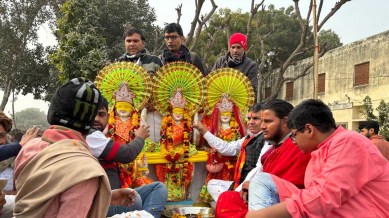Stay updated with the latest - Click here to follow us on Instagram
In a first, a temple that worships Ravan in Greater Noida village welcomes Ram
According to the chief priest of the temple, Mahant Ramdas, both Ram and Ravan give the same message to the society – of wisdom, valour, perseverance and respect for all.

Situated around 56 kilometres from the national capital, Greater Noida’s Bisrakh village has a unique distinction. Believed to be the birth place of Ravan, the village is known for worshipping the demon king. And even as most parts of the country celebrate “Ravan Dahan” (burning of the effigy of Ravan) on Vijayadashami, the residents here give the celebrations a miss. But on Monday, in an unprecedented move, idols of Lord Ram, Sita and Lakshman were installed inside the ancient Shiva temple here, to coincide with the Ram Temple consecration ceremony in Ayodhya.
According to the chief priest of the temple, Mahant Ramdas, both Ram and Ravan give the same message to the society – of wisdom, valour, perseverance and respect for all. “Ravan Maharaj came in my dreams and he said that we should make way for statues of Bhagwan Ram, Sita ji and Lakshman ji,” Mahant Ramdas told The Indian Express.
monthly limit of free stories.
with an Express account.
While the main gate of the temple is adorned by different statues depicting key moments in Ravan’s life, the sanctorum does not have any statue of the demon king. This too is set to change. “This Vijayadashami, we will install a statue of Ravan inside. Ram and Ravan share the same values, but different ideologies. Just like in today’s politics — the netas keep fighting in public but they meet each other cordially on different occasions,” said Mahant Ramdas.
“Today is a historic day as thousands of people came to the temple and celebrated the occasion,” he added.
While drawing a connection between Ram and Ravan from the mythology, he further said, “When Ram setu was being built to enter into Lanka, Ravan had performed a puja of Shri Ram. We want to give this message to the society that both can co-exist.”
It is believed that Ravan’s father Vishrawa was from Bisrakh village and was invited by Lord Shiva to perform rituals of Grih Pravesh when Lanka was being built for Goddess Parvati. According to mythology, after performing the puja, when Lord Shiva asked Vishrawa what he wanted as a Dakshina (gift), he demanded Lanka, which he later gave to his son Kuber. Lanka was taken over by Ravan later.
It is believed that the Shivling in the Shiva temple is the same where Ravan had offered his head 10 times as Tapasya.
Meanwhile, the village has no plans of burning the effigy of Ravan ever. “Though we have installed the statue of Ram, Ravan’s effigy will never be burnt in this village ever. Also, no Ramlila will be performed here. We will worship both (Ram and Ravan),” said Mahant Ramdas, who has been associated with the temple for around 40 years.